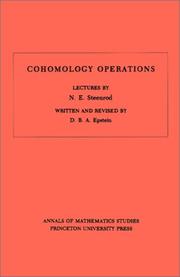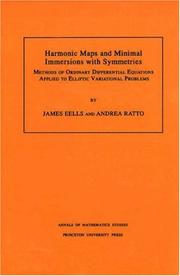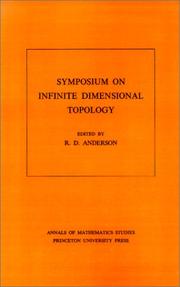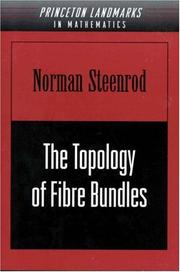| Listing 1 - 7 of 7 |
Sort by
|

ISBN: 0691079242 1400881676 Year: 2016 Publisher: Princeton, NJ : Princeton University Press,
Abstract | Keywords | Export | Availability | Bookmark
 Loading...
Loading...Choose an application
- Reference Manager
- EndNote
- RefWorks (Direct export to RefWorks)
Written and revised by D. B. A. Epstein.
Category theory. Homological algebra --- 515.14 --- Algebraic topology --- Homology theory. --- 515.14 Algebraic topology --- Cohomology theory --- Contrahomology theory --- Algebra homomorphism. --- Algebra over a field. --- Algebraic structure. --- Approximation. --- Axiom. --- Basis (linear algebra). --- CW complex. --- Cartesian product. --- Classical group. --- Coefficient. --- Cohomology operation. --- Cohomology ring. --- Cohomology. --- Commutative property. --- Complex number. --- Computation. --- Continuous function. --- Cup product. --- Cyclic group. --- Diagram (category theory). --- Dimension. --- Direct limit. --- Embedding. --- Existence theorem. --- Fibration. --- Homomorphism. --- Hopf algebra. --- Hopf invariant. --- Ideal (ring theory). --- Integer. --- Inverse limit. --- Manifold. --- Mathematics. --- Monomial. --- N-skeleton. --- Natural transformation. --- Permutation. --- Quaternion. --- Ring (mathematics). --- Scalar (physics). --- Special unitary group. --- Steenrod algebra. --- Stiefel manifold. --- Subgroup. --- Subset. --- Summation. --- Symmetric group. --- Symplectic group. --- Theorem. --- Uniqueness theorem. --- Upper and lower bounds. --- Vector field. --- Vector space. --- W0.

ISBN: 0691033218 069110249X 1400882508 9780691033211 9780691102498 Year: 2016 Volume: 130 Publisher: Princeton, NJ : Princeton University Press,
Abstract | Keywords | Export | Availability | Bookmark
 Loading...
Loading...Choose an application
- Reference Manager
- EndNote
- RefWorks (Direct export to RefWorks)
The aim of this book is to study harmonic maps, minimal and parallel mean curvature immersions in the presence of symmetry. In several instances, the latter permits reduction of the original elliptic variational problem to the qualitative study of certain ordinary differential equations: the authors' primary objective is to provide representative examples to illustrate these reduction methods and their associated analysis with geometric and topological applications. The material covered by the book displays a solid interplay involving geometry, analysis and topology: in particular, it includes a basic presentation of 1-cohomogeneous equivariant differential geometry and of the theory of harmonic maps between spheres.
Cartes harmoniques --- Harmonic maps --- Harmonische kaarten --- Immersies (Wiskunde) --- Immersions (Mathematics) --- Immersions (Mathématiques) --- Harmonic maps. --- Differential equations, Elliptic --- Applications harmoniques --- Immersions (Mathematiques) --- Équations différentielles elliptiques --- Numerical solutions. --- Solutions numériques --- Équations différentielles elliptiques --- Solutions numériques --- Differential equations [Elliptic] --- Numerical solutions --- Embeddings (Mathematics) --- Manifolds (Mathematics) --- Mappings (Mathematics) --- Maps, Harmonic --- Arc length. --- Catenary. --- Clifford algebra. --- Codimension. --- Coefficient. --- Compact space. --- Complex projective space. --- Connected sum. --- Constant curvature. --- Corollary. --- Covariant derivative. --- Curvature. --- Cylinder (geometry). --- Degeneracy (mathematics). --- Diagram (category theory). --- Differential equation. --- Differential geometry. --- Elliptic partial differential equation. --- Embedding. --- Energy functional. --- Equation. --- Existence theorem. --- Existential quantification. --- Fiber bundle. --- Gauss map. --- Geometry and topology. --- Geometry. --- Gravitational field. --- Harmonic map. --- Hyperbola. --- Hyperplane. --- Hypersphere. --- Hypersurface. --- Integer. --- Iterative method. --- Levi-Civita connection. --- Lie group. --- Mathematics. --- Maximum principle. --- Mean curvature. --- Normal (geometry). --- Numerical analysis. --- Open set. --- Ordinary differential equation. --- Parabola. --- Quadratic form. --- Sign (mathematics). --- Special case. --- Stiefel manifold. --- Submanifold. --- Suggestion. --- Surface of revolution. --- Symmetry. --- Tangent bundle. --- Theorem. --- Vector bundle. --- Vector space. --- Vertical tangent. --- Winding number. --- Differential equations, Elliptic - Numerical solutions


ISBN: 0691080879 1400881404 9780691080871 Year: 2016 Volume: 69 Publisher: Princeton, NJ : Princeton University Press,
Abstract | Keywords | Export | Availability | Bookmark
 Loading...
Loading...Choose an application
- Reference Manager
- EndNote
- RefWorks (Direct export to RefWorks)
In essence the proceedings of the 1967 meeting in Baton Rouge, the volume offers significant papers in the topology of infinite dimensional linear spaces, fixed point theory in infinite dimensional spaces, infinite dimensional differential topology, and infinite dimensional pointset topology. Later results of the contributors underscore the basic soundness of this selection, which includes survey and expository papers, as well as reports of continuing research.
Topology --- Differential geometry. Global analysis --- Differential topology --- Functional analysis --- Congresses --- Analyse fonctionnnelle --- Geometry, Differential --- Anderson's theorem. --- Annihilator (ring theory). --- Automorphism. --- Baire measure. --- Banach algebra. --- Banach manifold. --- Banach space. --- Bounded operator. --- Cartesian product. --- Characterization (mathematics). --- Cohomology. --- Compact space. --- Complement (set theory). --- Complete metric space. --- Connected space. --- Continuous function. --- Convex set. --- Coset. --- Critical point (mathematics). --- Diagram (category theory). --- Differentiable manifold. --- Differential topology. --- Dimension (vector space). --- Dimension. --- Dimensional analysis. --- Dual space. --- Duality (mathematics). --- Endomorphism. --- Equivalence class. --- Euclidean space. --- Existential quantification. --- Explicit formulae (L-function). --- Exponential map (Riemannian geometry). --- Fixed-point theorem. --- Fréchet derivative. --- Fréchet space. --- Fuchsian group. --- Function space. --- Fundamental class. --- Haar measure. --- Hessian matrix. --- Hilbert space. --- Homeomorphism. --- Homology (mathematics). --- Homotopy group. --- Homotopy. --- Inclusion map. --- Infimum and supremum. --- Lebesgue space. --- Lefschetz fixed-point theorem. --- Limit point. --- Linear space (geometry). --- Locally convex topological vector space. --- Loop space. --- Mathematical optimization. --- Measure (mathematics). --- Metric space. --- Module (mathematics). --- Natural topology. --- Neighbourhood (mathematics). --- Normal space. --- Normed vector space. --- Open set. --- Ordinal number. --- Paracompact space. --- Partition of unity. --- Path space. --- Product topology. --- Quantifier (logic). --- Quotient space (linear algebra). --- Quotient space (topology). --- Radon measure. --- Reflexive space. --- Representation theorem. --- Riemannian manifold. --- Schauder fixed point theorem. --- Sign (mathematics). --- Simply connected space. --- Space form. --- Special case. --- Stiefel manifold. --- Strong operator topology. --- Subcategory. --- Submanifold. --- Subset. --- Tangent space. --- Teichmüller space. --- Theorem. --- Topological space. --- Topological vector space. --- Topology. --- Transfinite induction. --- Transfinite. --- Transversal (geometry). --- Transversality theorem. --- Tychonoff cube. --- Union (set theory). --- Unit sphere. --- Weak topology. --- Weakly compact. --- Differential topology - Congresses --- Functional analysis - Congresses --- Topology - Congresses

ISBN: 0691080550 0691005486 1400883873 9780691080550 Year: 1951 Volume: 14 Publisher: Princeton (N.J.): Princeton university press
Abstract | Keywords | Export | Availability | Bookmark
 Loading...
Loading...Choose an application
- Reference Manager
- EndNote
- RefWorks (Direct export to RefWorks)
Fibre bundles, now an integral part of differential geometry, are also of great importance in modern physics--such as in gauge theory. This book, a succinct introduction to the subject by renown mathematician Norman Steenrod, was the first to present the subject systematically. It begins with a general introduction to bundles, including such topics as differentiable manifolds and covering spaces. The author then provides brief surveys of advanced topics, such as homotopy theory and cohomology theory, before using them to study further properties of fibre bundles. The result is a classic and timeless work of great utility that will appeal to serious mathematicians and theoretical physicists alike.
#WWIS:d.d. Prof. L. Bouckaert/ALTO --- 515.1 --- 515.1 Topology --- Topology --- Topology. --- Analysis situs --- Position analysis --- Rubber-sheet geometry --- Geometry --- Polyhedra --- Set theory --- Algebras, Linear --- Algebraic topology. --- Associated bundle. --- Associative algebra. --- Associative property. --- Atlas (topology). --- Automorphism. --- Axiomatic system. --- Barycentric subdivision. --- Bilinear map. --- Bundle map. --- Classification theorem. --- Coefficient. --- Cohomology ring. --- Cohomology. --- Conjugacy class. --- Connected component (graph theory). --- Connected space. --- Coordinate system. --- Coset. --- Cup product. --- Cyclic group. --- Determinant. --- Differentiable manifold. --- Differential structure. --- Dimension (vector space). --- Direct product. --- Division algebra. --- Equivalence class. --- Equivalence relation. --- Euler number. --- Existence theorem. --- Existential quantification. --- Factorization. --- Fiber bundle. --- Frenet–Serret formulas. --- Gram–Schmidt process. --- Group theory. --- Homeomorphism. --- Homology (mathematics). --- Homomorphism. --- Homotopy group. --- Homotopy. --- Hopf theorem. --- Hurewicz theorem. --- Identity element. --- Inclusion map. --- Inner automorphism. --- Invariant subspace. --- Invertible matrix. --- Jacobian matrix and determinant. --- Klein bottle. --- Lattice of subgroups. --- Lie group. --- Line element. --- Line segment. --- Linear map. --- Linear space (geometry). --- Linear subspace. --- Manifold. --- Mapping cylinder. --- Metric tensor. --- N-sphere. --- Natural topology. --- Octonion. --- Open set. --- Orientability. --- Orthogonal group. --- Orthogonalization. --- Permutation. --- Principal bundle. --- Product topology. --- Quadratic form. --- Quaternion. --- Retract. --- Separable space. --- Set theory. --- Simplicial complex. --- Special case. --- Stiefel manifold. --- Subalgebra. --- Subbase. --- Subgroup. --- Subset. --- Symmetric tensor. --- Tangent bundle. --- Tangent space. --- Tangent vector. --- Tensor field. --- Tensor. --- Theorem. --- Tietze extension theorem. --- Topological group. --- Topological space. --- Transitive relation. --- Transpose. --- Union (set theory). --- Unit sphere. --- Universal bundle. --- Vector field.
Book
Year: 2022 Publisher: Basel MDPI - Multidisciplinary Digital Publishing Institute
Abstract | Keywords | Export | Availability | Bookmark
 Loading...
Loading...Choose an application
- Reference Manager
- EndNote
- RefWorks (Direct export to RefWorks)
Extremely popular for statistical inference, Bayesian methods are also becoming popular in machine learning and artificial intelligence problems. Bayesian estimators are often implemented by Monte Carlo methods, such as the Metropolis–Hastings algorithm of the Gibbs sampler. These algorithms target the exact posterior distribution. However, many of the modern models in statistics are simply too complex to use such methodologies. In machine learning, the volume of the data used in practice makes Monte Carlo methods too slow to be useful. On the other hand, these applications often do not require an exact knowledge of the posterior. This has motivated the development of a new generation of algorithms that are fast enough to handle huge datasets but that often target an approximation of the posterior. This book gathers 18 research papers written by Approximate Bayesian Inference specialists and provides an overview of the recent advances in these algorithms. This includes optimization-based methods (such as variational approximations) and simulation-based methods (such as ABC or Monte Carlo algorithms). The theoretical aspects of Approximate Bayesian Inference are covered, specifically the PAC–Bayes bounds and regret analysis. Applications for challenging computational problems in astrophysics, finance, medical data analysis, and computer vision area also presented.
Research & information: general --- Mathematics & science --- bifurcation --- dynamical systems --- Edward–Sokal coupling --- mean-field --- Kullback–Leibler divergence --- variational inference --- Bayesian statistics --- machine learning --- variational approximations --- PAC-Bayes --- expectation-propagation --- Markov chain Monte Carlo --- Langevin Monte Carlo --- sequential Monte Carlo --- Laplace approximations --- approximate Bayesian computation --- Gibbs posterior --- MCMC --- stochastic gradients --- neural networks --- Approximate Bayesian Computation --- differential evolution --- Markov kernels --- discrete state space --- ergodicity --- Markov chain --- probably approximately correct --- variational Bayes --- Bayesian inference --- Markov Chain Monte Carlo --- Sequential Monte Carlo --- Riemann Manifold Hamiltonian Monte Carlo --- integrated nested laplace approximation --- fixed-form variational Bayes --- stochastic volatility --- network modeling --- network variability --- Stiefel manifold --- MCMC-SAEM --- data imputation --- Bethe free energy --- factor graphs --- message passing --- variational free energy --- variational message passing --- approximate Bayesian computation (ABC) --- differential privacy (DP) --- sparse vector technique (SVT) --- Gaussian --- particle flow --- variable flow --- Langevin dynamics --- Hamilton Monte Carlo --- non-reversible dynamics --- control variates --- thinning --- meta-learning --- hyperparameters --- priors --- online learning --- online optimization --- gradient descent --- statistical learning theory --- PAC–Bayes theory --- deep learning --- generalisation bounds --- Bayesian sampling --- Monte Carlo integration --- PAC-Bayes theory --- no free lunch theorems --- sequential learning --- principal curves --- data streams --- regret bounds --- greedy algorithm --- sleeping experts --- entropy --- robustness --- statistical mechanics --- complex systems
Book
Year: 2022 Publisher: Basel MDPI - Multidisciplinary Digital Publishing Institute
Abstract | Keywords | Export | Availability | Bookmark
 Loading...
Loading...Choose an application
- Reference Manager
- EndNote
- RefWorks (Direct export to RefWorks)
Extremely popular for statistical inference, Bayesian methods are also becoming popular in machine learning and artificial intelligence problems. Bayesian estimators are often implemented by Monte Carlo methods, such as the Metropolis–Hastings algorithm of the Gibbs sampler. These algorithms target the exact posterior distribution. However, many of the modern models in statistics are simply too complex to use such methodologies. In machine learning, the volume of the data used in practice makes Monte Carlo methods too slow to be useful. On the other hand, these applications often do not require an exact knowledge of the posterior. This has motivated the development of a new generation of algorithms that are fast enough to handle huge datasets but that often target an approximation of the posterior. This book gathers 18 research papers written by Approximate Bayesian Inference specialists and provides an overview of the recent advances in these algorithms. This includes optimization-based methods (such as variational approximations) and simulation-based methods (such as ABC or Monte Carlo algorithms). The theoretical aspects of Approximate Bayesian Inference are covered, specifically the PAC–Bayes bounds and regret analysis. Applications for challenging computational problems in astrophysics, finance, medical data analysis, and computer vision area also presented.
Research & information: general --- Mathematics & science --- bifurcation --- dynamical systems --- Edward–Sokal coupling --- mean-field --- Kullback–Leibler divergence --- variational inference --- Bayesian statistics --- machine learning --- variational approximations --- PAC-Bayes --- expectation-propagation --- Markov chain Monte Carlo --- Langevin Monte Carlo --- sequential Monte Carlo --- Laplace approximations --- approximate Bayesian computation --- Gibbs posterior --- MCMC --- stochastic gradients --- neural networks --- Approximate Bayesian Computation --- differential evolution --- Markov kernels --- discrete state space --- ergodicity --- Markov chain --- probably approximately correct --- variational Bayes --- Bayesian inference --- Markov Chain Monte Carlo --- Sequential Monte Carlo --- Riemann Manifold Hamiltonian Monte Carlo --- integrated nested laplace approximation --- fixed-form variational Bayes --- stochastic volatility --- network modeling --- network variability --- Stiefel manifold --- MCMC-SAEM --- data imputation --- Bethe free energy --- factor graphs --- message passing --- variational free energy --- variational message passing --- approximate Bayesian computation (ABC) --- differential privacy (DP) --- sparse vector technique (SVT) --- Gaussian --- particle flow --- variable flow --- Langevin dynamics --- Hamilton Monte Carlo --- non-reversible dynamics --- control variates --- thinning --- meta-learning --- hyperparameters --- priors --- online learning --- online optimization --- gradient descent --- statistical learning theory --- PAC–Bayes theory --- deep learning --- generalisation bounds --- Bayesian sampling --- Monte Carlo integration --- PAC-Bayes theory --- no free lunch theorems --- sequential learning --- principal curves --- data streams --- regret bounds --- greedy algorithm --- sleeping experts --- entropy --- robustness --- statistical mechanics --- complex systems
Book
Year: 2022 Publisher: Basel MDPI - Multidisciplinary Digital Publishing Institute
Abstract | Keywords | Export | Availability | Bookmark
 Loading...
Loading...Choose an application
- Reference Manager
- EndNote
- RefWorks (Direct export to RefWorks)
Extremely popular for statistical inference, Bayesian methods are also becoming popular in machine learning and artificial intelligence problems. Bayesian estimators are often implemented by Monte Carlo methods, such as the Metropolis–Hastings algorithm of the Gibbs sampler. These algorithms target the exact posterior distribution. However, many of the modern models in statistics are simply too complex to use such methodologies. In machine learning, the volume of the data used in practice makes Monte Carlo methods too slow to be useful. On the other hand, these applications often do not require an exact knowledge of the posterior. This has motivated the development of a new generation of algorithms that are fast enough to handle huge datasets but that often target an approximation of the posterior. This book gathers 18 research papers written by Approximate Bayesian Inference specialists and provides an overview of the recent advances in these algorithms. This includes optimization-based methods (such as variational approximations) and simulation-based methods (such as ABC or Monte Carlo algorithms). The theoretical aspects of Approximate Bayesian Inference are covered, specifically the PAC–Bayes bounds and regret analysis. Applications for challenging computational problems in astrophysics, finance, medical data analysis, and computer vision area also presented.
bifurcation --- dynamical systems --- Edward–Sokal coupling --- mean-field --- Kullback–Leibler divergence --- variational inference --- Bayesian statistics --- machine learning --- variational approximations --- PAC-Bayes --- expectation-propagation --- Markov chain Monte Carlo --- Langevin Monte Carlo --- sequential Monte Carlo --- Laplace approximations --- approximate Bayesian computation --- Gibbs posterior --- MCMC --- stochastic gradients --- neural networks --- Approximate Bayesian Computation --- differential evolution --- Markov kernels --- discrete state space --- ergodicity --- Markov chain --- probably approximately correct --- variational Bayes --- Bayesian inference --- Markov Chain Monte Carlo --- Sequential Monte Carlo --- Riemann Manifold Hamiltonian Monte Carlo --- integrated nested laplace approximation --- fixed-form variational Bayes --- stochastic volatility --- network modeling --- network variability --- Stiefel manifold --- MCMC-SAEM --- data imputation --- Bethe free energy --- factor graphs --- message passing --- variational free energy --- variational message passing --- approximate Bayesian computation (ABC) --- differential privacy (DP) --- sparse vector technique (SVT) --- Gaussian --- particle flow --- variable flow --- Langevin dynamics --- Hamilton Monte Carlo --- non-reversible dynamics --- control variates --- thinning --- meta-learning --- hyperparameters --- priors --- online learning --- online optimization --- gradient descent --- statistical learning theory --- PAC–Bayes theory --- deep learning --- generalisation bounds --- Bayesian sampling --- Monte Carlo integration --- PAC-Bayes theory --- no free lunch theorems --- sequential learning --- principal curves --- data streams --- regret bounds --- greedy algorithm --- sleeping experts --- entropy --- robustness --- statistical mechanics --- complex systems
| Listing 1 - 7 of 7 |
Sort by
|

 Search
Search Feedback
Feedback About
About Help
Help News
News